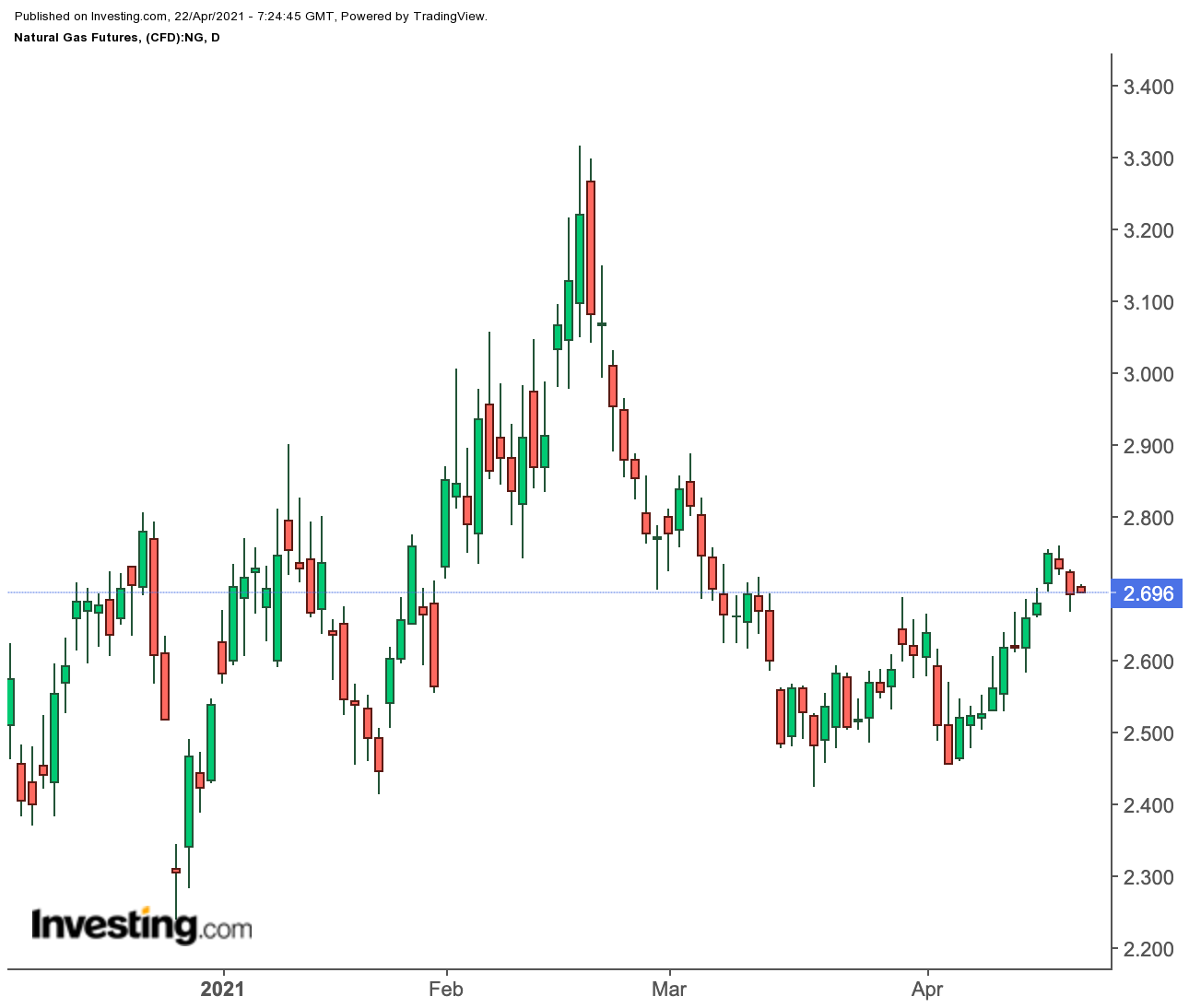The US cold season is overstaying its welcome and no one is more impatient to see its end than natural gas bears.
Since mid-March, chilly winds have been the staple in the US Northeast to Midwest regions, defying initial forecasts for bland spring weather.
The result has been smaller-than-expected gas injections into storage over the past three weeks as utilities’ burn rates for heat and power generation versus production continually exceeded forecasts.
As late as Wednesday, a blanket of heavy wet snow cloaked much of Ohio, a state in the US Midwest, resulting in scattered power outages. The snowfall ranged from a coating in the southeastern counties to four to eight inches in the north.

The impact of all this has been a combined 7% rally on the New York Mercantile Exchange’s Henry Hub over the past two weeks. On Tuesday, the front-month futures contract on the hub hit a seven-week high of $2.759 per mmBtu, or million metric British thermal units.
While the contract declined more than 1% on Wednesday, it was still on firm ground to hold the $2.70 level, analysts said.
More Upside For Natural Gas In Near Term
Technical charts of natural gas also suggest more upside in the near term.
Investing.com’s Daily Technical Outlook shows that should the market extend its bullish trend, it is likely to run into a three-tier resistance, first at $2.722, then $2.753 and later at $2.781.
In the event of a turnaround, then a three-stage support could form, first at $2.663, then $2.635 and later at $2.604.
It is against this backdrop that another weekly update on US natural gas storage is due from the Energy Information Administration at 10:30 AM ET (14:30 GMT) today.
A consensus of estimates from industry analysts tracked by Investing.com shows the EIA is likely to report an addition of 49 bcf, or billion cubic feet, to storage for the week ended Apr. 16.
That would be higher than the 43-bcf injection seen during the same week a year ago, and also above the five-year (2016-2020) average injection of 37 bcf.
The estimate would, of course, be nothing if the injection into storage turned out to be lower than expected, as in the past three weeks.
For the week ended Apr. 9, the forecast build was 67 bcf but the actual number reported was 61 bcf; in the preceding week, the estimated injection was 21 bcf versus a final number of 20 bcf; and in the week prior, the targeted increase was 21 bcf against an injection of 14 bcf.
Latest Storage Data Will Show Cold Impact
Gelber & Associates, a Houston-based gas markets consultancy, said in a note issued to its clients and shared with Investing.com on Wednesday:
“Tomorrow’s injection will be a telling sign as to how much cold is actually materializing and current fundamental balances.”
“The seven day average for production is now sub-91 bcf, sitting at 90.6 bcf as residuals continue moving down. Even so, the injection for the week ending Apr. 23 will be much smaller than the injection last week, and compared to average, will be much more bullish for natural gas prices.”
If analysts are on target with their 49-bcf estimate for the week to Apr. 16, the injection would take US gas stockpiles to 1.894 tcf, or trillion cubic feet—up 1.2% over the five-year average but 11.5% below the same week a year ago.
There were 72 HDDs, or heating degree days, last week compared with a 30-year average of 78 HDDs for the period, according to data provider Refinitiv.
HDDs are used to estimate demand to heat homes and businesses and measure the number of degrees a day's average temperature is below 65 degrees Fahrenheit (18 degrees Celsius).
Be that as it may be, Bespoke Weather Services said power burns remained “quite weak” in its weather-adjusted model, so the changes day to day were in the bearish direction.
In a post on the naturalgasintel.com site, the firm said these changes indicated that a dip back to “$2.65 - $2.68 is more likely than a retest of $2.75, at least in the near term.”
Bespoke’s rival, NatGasWeather, concurred with that.
Weather Pattern May Turn Bearish
NatGasWeather said the midday Global Forecast System weather model was a little chillier later this weekend and early next week as cool air is expected to linger across the northern United States slightly stronger and longer.
But the weather pattern from Apr. 27 to May 5 could be “slightly bearish,” it said.
On the production front, gas output took a dramatic decline last weekend, according to Wood Mackenzie. The firm said output fell from 92.1 bcf per day on Apr. 16 to 90.3 bcf on Monday and then to a recent low of 89.4 bcf on Tuesday.
“Because of the location of the points and the timing of the flows, the temporary outage appears to be operator field maintenance, common during these shoulder season months,” Wood Mackenzie analyst Nichole McMurrer said.
Permian Basin production in the Texas portion of the play also fell over the weekend. Output dropped to 8.5 bcf per day on Tuesday from 9.3 bcf last Friday. However, production appeared to be recovering a bit at midweek, according to the firm.
Feed gas volumes for liquefied natural gas sank slightly further to around 11.2 bcf, the lowest level since Apr. 14, when deliveries to US terminals fell to 11.4 bcf.
Disclaimer: Barani Krishnan uses a range of views outside his own to bring diversity to his analysis of any market. For neutrality, he sometimes presents contrarian views and market variables. He does not hold a position in the commodities and securities he writes about.
